July 8th, 2012
| 1 Comment »
Summer kind of smacked us around this past week in Minnesota. We’re a state that lives for Summer, for beach time and hours spent outdoors engaging in just about any activity that means we escape our houses and enjoy the weather, but then there are those Summer days that are so hot, so thickly humid and uncomfortable that we have no choice but to stay home, avoid the triple digits outdoors and attempt to entertain ourselves while the sun tries to burn holes in our roof.
I’ve experienced some hot Summers in my lifetime; 1988 was a blistering hot Summer that saw temperature records fall by the score, knocking out ones that had stood the test of time since the 1930’s. I was living in a third floor walk-up apartment with no A/C and I’ve never been so miserable in my life. One evening in July, as I sat out on the stoop with other exhausted and over-heated residents of our building, the night air at 10:30 was still hovering around 105°. Trying to sleep was impossible. At 3:30 that morning, I finally gave up and turned on the radio, only to hear that the current temperature was 88°. During that particular Summer, we saw a stretch of weather where the temperature did not fall below 85° for more than a week. At that point in time, central air-conditioning was still a novelty.
I don’t recall much about what I ate during that sweltering Summer, and having this cool, crunchy and fresh salad around might have made those awful days a bit more tolerable, but at that point in my life, my culinary exploits were just about non-existent. Thankfully, for our current heat wave, and after a quick and sweaty trip through the Farmers Market, we were stocked to the hilt with fresh greens and lettuces and crisp vegetables, making this dish a mainstay of those sticky days blessedly spent inside our comfortable, fully air-conditioned house.
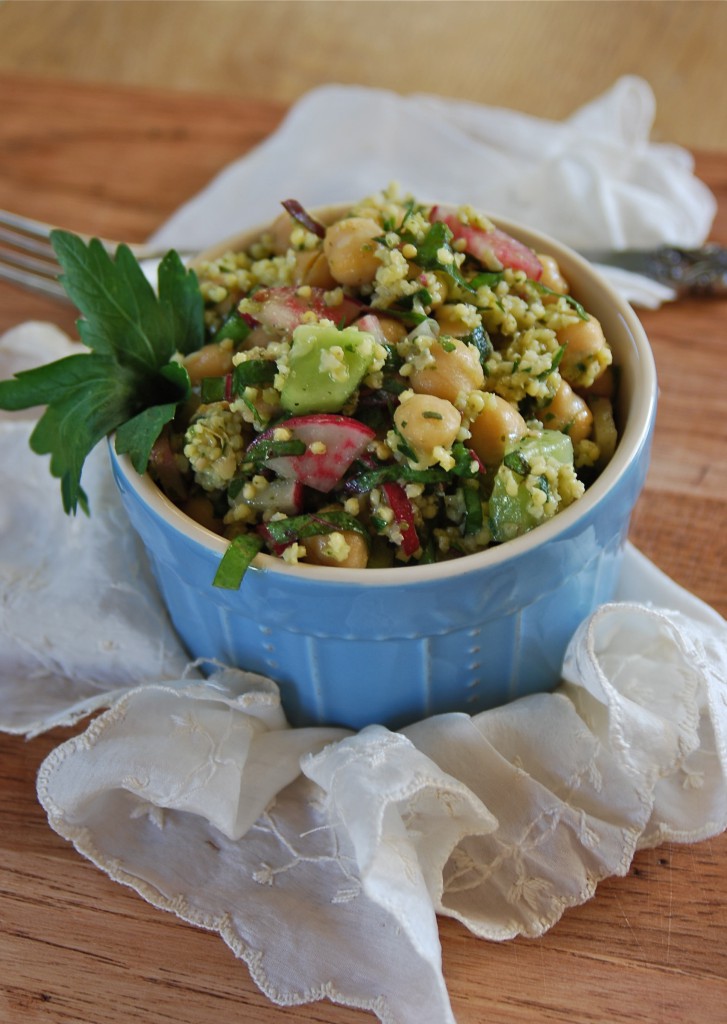
Not familiar with millet? Most of us in the USA see it only in birdseed, and that’s a sad fate for us humans, but terrific for the birds. Millet is widely cultivated in the form of pearl millet in India and parts of Africa, and is popular there due to it’s high productivity and and short growing season. In the USA, the most widely cultivated form of millet is proso millet, grown and used as birdseed. Millet is an ancient grain, known for being the least allergenic and most digestible of the gluten-free ancient grains that are becoming more popular. Millet is high in fiber and all the B vitamins, iron, calcium and zinc. It cooks in less time than quinoa and has a pleasantly sweet and nutty flavor.
This salad, born of desperation and some choice nightmares over stressful memories of past sticky summers, made our stretch of housebound days feel a bit easier. Even in the cool comfort of home, with the heat and humidity kept at bay by closed shades, eating becomes almost an afterthought. There’s no comfort in foods that are heavy or rich; no desire for flame or heat, and when the mood strikes to eat something, it’s good to just reach in the refrigerator and pull out a bowl of summertime goodness. The crunch and snap of fresh vegetables, the headiness of herbs cut straight from the garden outside your door and a blind eye turned from the weather forecast was welcome relief as the calendar page turned to July.
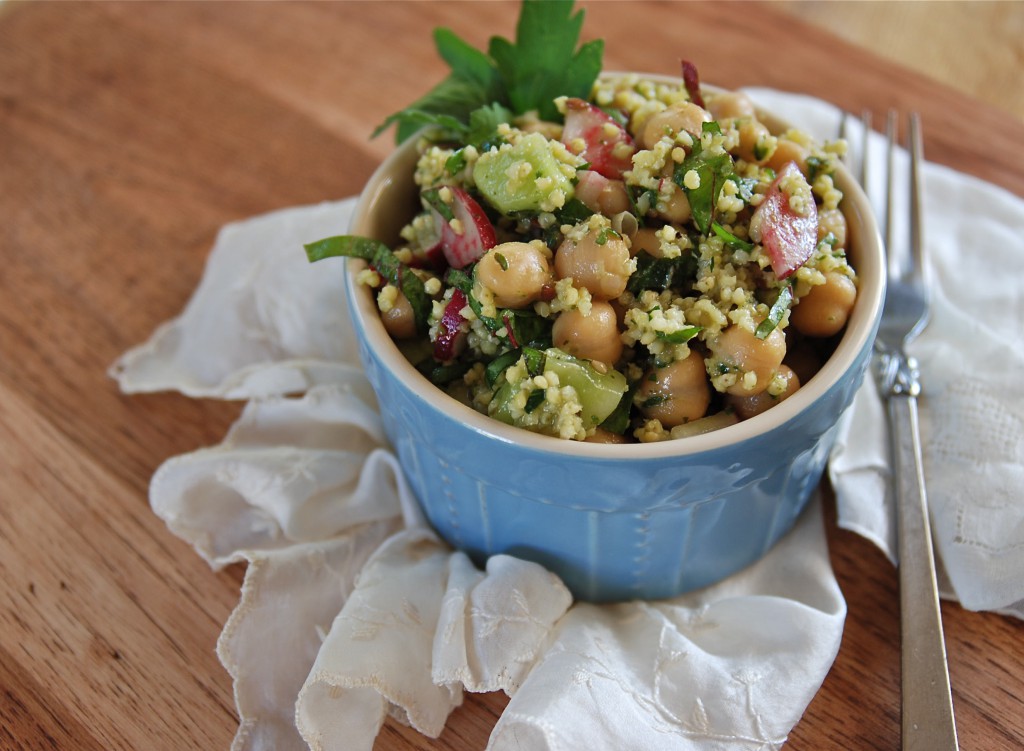
This salad is endlessly versatile, and if Millet isn’t available, you can use just about any small grain you wish. With the wide variety of fresh vegetables in season, as well as delicious greens, putting your own personal thumbprint on this salad is a cinch. I loved the addition of the radish greens to the salad, offering their unique peppery bite, but if you use them, seek out organic radishes to insure that the greens aren’t laden with pesticide residue. And as always, with time in the refrigerator, this salad takes on a lot more flavor.
Now we’re all set for the next heat wave. Let’s just hope it’s not too soon.
Millet & Chickpea Salad
1/2 c. raw millet
1 15-oz can chickpeas, drained and rinsed
1 small cucumber, peeled and diced (remove the seeds if desired)
1 small bunch radishes and their greens, washed and sliced
1 c. fresh chopped herbs such as basil, oregano, thyme and parsley
1/4 c. good quality olive oil
2 T. white or red wine vinegar
Sea salt and fresh cracked pepper to taste
In a small saucepan, bring 1-1/2 cups of water to a boil. Rinse millet in a wire mesh strainer until the water runs clear. Add millet to boiling water with a generous pinch of salt. Bring to a boil, reduce the heat and simmer for about 10 minutes. Test the grains. They should still be firm, with a bit of softness, like rice. All the water might not be absorbed either. If tender, remove from heat and drain remaining water. Spread cooked millet on a parchment lined baking sheet to cool.
In a large bowl, combine the cooled millet, chickpeas, cucumber, and radish, greens included. Whisk the oil and vinegar together in a small measuring cup, season with salt and pepper. Pour over vegetables and toss to coat. Taste and season with more salt and pepper, if you wish. Add half the herbs, toss together. Chill for about an hour. Taste before serving, adding more seasoning and herbs to boost flavor.
March 25th, 2009
| 5 Comments »
I am one of those cooks who use recipes only as a fundamental guideline to a finished product. I can trust my own cooking skills enough, and what I know about how my family eats, to be confident when I look at a recipe in determining what ingredients in it won’t work, or what needs to be enhanced. Even simple basic products can be made better with a little creativity and an eye towards a higher nutritional value.
Take a jar of spaghetti sauce. It’s high on the convenience scale, and has a reasonable amount of nutritional value, provided you avoid the sugar-laden brands and stick with a purer variety. With the addition of sauteed onion and garlic, along with shredded zucchini, carrot and spinach, a few chopped fresh roma tomatoes, some fresh basil or rosemary and a little tomato paste to bring it all together, you get a pasta sauce brimming with vegeteble content, better flavor and more nutrition.
I often come across recipes too, that when I do follow them to the letter and get that anticipatory excitement of what the finished product will be, I often end up sorely disappointed, especially if I ignore my inner urgings to add something of my own liking. It is a rare occurence indeed when I work through a recipe and come to a conclusion, after following the prescribed steps, that what I see in front of me might be way better than what the original end result offered. That was the case with this Savory Millet Risotto.
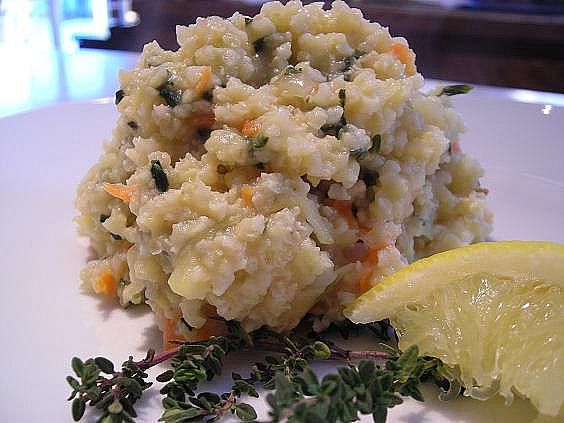
The recipe, from the current issue of Eating Well magazine, was supposed to be for a Millet Cake, similar in structure and use to Polenta. Even though I have given up on using Polenta in any of my meals after repeated attempts to enjoy it always fell flat, I earmarked this recipe as an option. The millet cooks with shredded vegetables, parmesan cheese, fresh thyme and lemon zest to a creamy consistency, at which point it would be cooled, then shaped into patties to sear in a pan. It never made it that far.
Come in to my kitchen…
March 15th, 2009
| 3 Comments »
Seemingly a whole lifetime ago, I worked for five years in the office of a wholesale bakery and I have to say, the smell of yeast has been and still is one of my most favorite smells of all. I loved walking through the production area in the early afternoons as the baking staff began their daily preparations; I loved standing by the enormous mixing bowls as hundreds of pounds of bread dough, pungent with the scent of yeast and flour, spun and smacked around inside. It was a happy day indeed when my boss would inform me that they would be making test batches that day because I knew he would be bringing me endless samples of warm bread to critique. And the best perk was free bread for the taking- crispy baguettes that snapped when you broke them, showering golden shards of crust everywhere, tangy sourdoughs, pillowy stirato loaves, rustic wheat breads and a mouth-watering marble rye that was my favorite sandwich loaf. The best lunch I could indulge myself in was a sliced baguette spread with a little of their scratch aioli and a few slices of salty ham. I was in carb heaven. I still miss the amazing bread, and it’s been a very long time since I last walked through those doors. I can buy the loaves in the grocers, and the flavor is still good, but I miss the experience of picking up a loaf off the rack that was only hours out of the oven, ethereal in it’s taste.
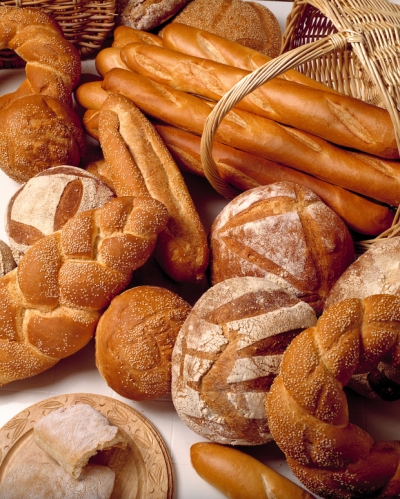 I still love really good bread and for a long time I routinely spun loads of flour, water and yeast in my bread machine, so much so that I managed to effectively kill the thing outright, but I’m happy to have gotten my money’s worth. Since then, which was quite a while ago, I haven’t made a lot of bread from scratch despite having the time and the desire for it. I experimented with this amazing no-knead bread and loved the rich dense crumb and tangy flavor, but I am plagued with a ‘Must Have It Now’ mentality sometimes, and this just doesn’t work well with the patience and time required for a good loaf of scratch bread. There are some high quality artisan bakeries in the Twin Cities, including my old employ, and for a short trip in the car I can pick up a few loaves of bread to indulge myself in, but what I really need to do instead is lose the impatience inside of me and buckle down to make myself a good loaf on a regular basis. I still love really good bread and for a long time I routinely spun loads of flour, water and yeast in my bread machine, so much so that I managed to effectively kill the thing outright, but I’m happy to have gotten my money’s worth. Since then, which was quite a while ago, I haven’t made a lot of bread from scratch despite having the time and the desire for it. I experimented with this amazing no-knead bread and loved the rich dense crumb and tangy flavor, but I am plagued with a ‘Must Have It Now’ mentality sometimes, and this just doesn’t work well with the patience and time required for a good loaf of scratch bread. There are some high quality artisan bakeries in the Twin Cities, including my old employ, and for a short trip in the car I can pick up a few loaves of bread to indulge myself in, but what I really need to do instead is lose the impatience inside of me and buckle down to make myself a good loaf on a regular basis.
On a recent trip through the library, I came across the publication of a local group called The Saint Paul Bread Club. I barely hesitated before slipping the slim book off the shelf. It’s basic and fundamental, nothing glossy or fancy, just page after page of bread recipes from a local group of passionate bread bakers, along with plenty of insider tips and hints to making better breads at home. After a few perusals and some thought to the first loaf to try, I rolled out of bed on a particularly gloomy morning after a simply pathetic night’s sleep and all I could think about was the smell of yeast, a warm glowing oven and the taste of a fresh warm loaf. The weather promised everything from rain to an eventual accumulation of upwards of 6″ of snow. It instilled in me both a bluesy melancholy, and a fierce need for the routine of baking, the rhythmic kneading and the promise of carbohydrates.

This loaf contained bulgur and millet and I had both on hand. Bulgur is cracked and parboiled wheat and really simple to use- it requires little else but a soak in hot water. Millet is a hulled, wheat-free cereal grain- the outer husk is removed leaving tiny yellow balls. Millet requires cooking, but this recipe didn’t make any mention of pre-cooking the grain so I didn’t, and it plagued me on whether or not this would result in a tooth-cracking slice. It didn’t.

This recipe started with a sponge- honey, warm water and yeast were whisked together until foamy, then stirred with whole wheat flour, bulgur, oil and salt and allowed to sit until all puffy and fragrant. I mixed in the bread flour and millet, and pretty soon was faced with a coarse hairy blob of dough, and tiny grains of millet popping all over the kitchen. It seemed like hours before I stopped feeling their little hard knobs under my feet, even with obsessive sweeping. But the magic of kneading kicks in- and magic it is- taking a rough and craggy blob and transforming it into something smooth, elastic and uniform, dotted with the tiny yellow points of millet and smelling alive and warm.
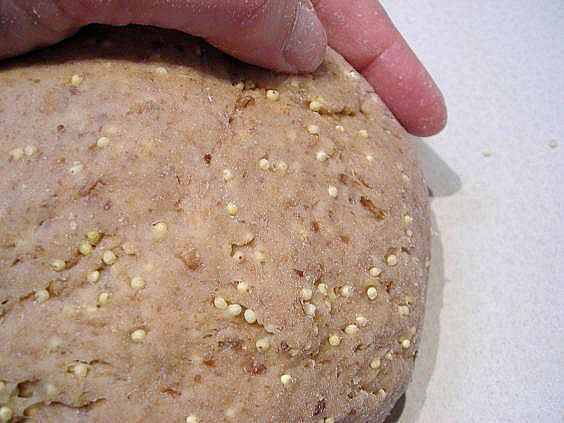 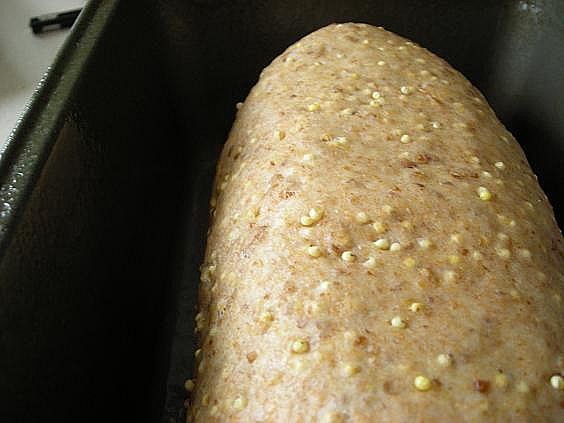 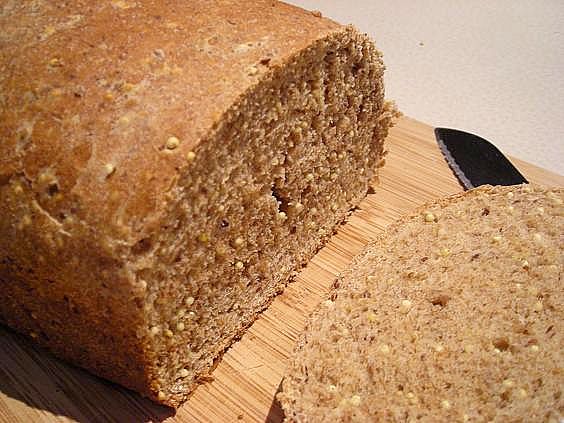
The rest is your basic bread instructions; rise until doubled, punch down and allow another rise (which I skipped for time purposes) shape the loaves and place in a pan, rise to double again and then bake. I won’t bore you with instructions.
And somewhere along the way, amidst all this tactile interaction and flour/yeast transformation, a tiny sliver of light knifed through me, lifting the melancholy, driving it far away. Was it the nap I took during the first rise? Maybe. It likely was something else altogether; the bread making lifted my spirits, even with the late winter storm blowing hard outside and the yeast saturated me with it’s own little charm. It could have been the workout I gave my arms and shoulders as I kneaded, driving a much appreciated blast of endorphins into me, or it could have been the fact that a hands-on loaf of bread is a thing of beauty. It transports you back to a simpler time, before cellophane loaves were the norm, where you watch a few pantry staples work a magic trick right before your very eyes. It’s nearly impossible to bury yourself in the blues with that happening in front of you.
And the taste….well, that’s enough right there to lift your spirits. This loaf was moist, a nice dense crust and crunchy little bites of millet throughout. It made awesome toast too- to me, the best indicator of a good bread. I’m thinking that I need to buy this little bread book.
(recipe after the jump)
Come in to my kitchen…
May 27th, 2008
| 7 Comments »
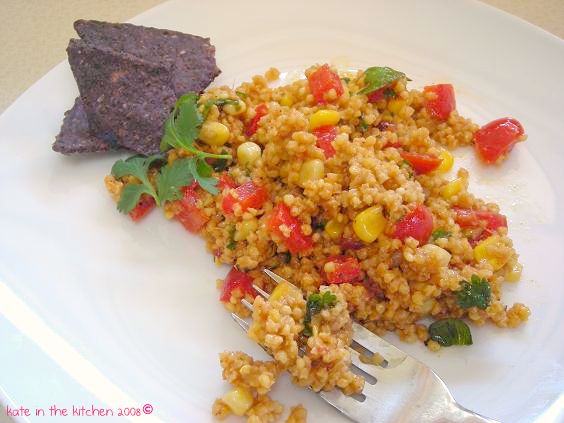
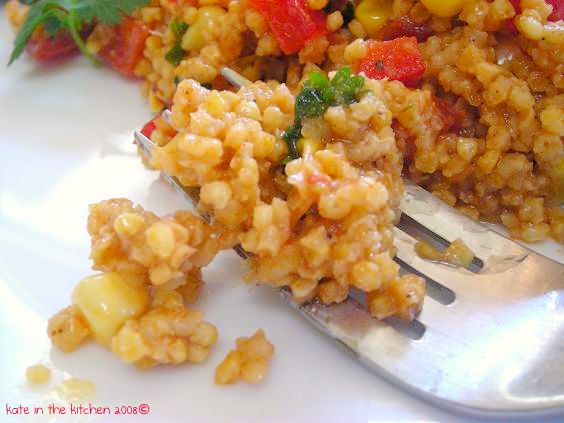
African Millet Salad with Corn and Peppers
from The New Whole Grains Cookbook by Robin Asbell
3 T. olive oil
1 medium onion, julienned
2 T. chopped garlic
2 T. minced ginger
1 T. paprika
1 t. black pepper
1/8 t. ground allspice
1/8 t. cayenne pepper, or to taste
1 c. millet
1 t. salt
1/4 c. lemon juice
1 T. brown sugar
1 8-oz can extra crunchy corn
1 small green bell pepper, chopped
1 roma tomato, chopped
1/4 c. parsley, chopped
1/4 c. roasted peanuts, chopped
In a 2-qt saucepan with a tight fitting lid, heat 1 T. of oil and saute onion until golden. Add garlic and ginger and cook for one minutes, then add paprika, black pepper, allspice, and cayenne and cook for one minute more. Wash millet quickly and drain; add to pan and stir, coating grains and cooking until hot to the touch. Add water and salt and bring to boil, then reduce heat and simmer on low for 20 minutes before checking for doneness**. When all liquid is absorbed and grain is tender, cover and remove from heat, allowing to steam for 10 minutes. Scrape millet into bowl and cover, then let cool. Whisk remaining oil with lemon juice and brown sugar in a small bowl. Stir corn, bell pepper, tomato and parsley in with the millet, then drizzle dressing over and stir to coat. Serve topped with peanuts.
KATE’S NOTES:
I used cilantro in place of parsley as I had it on hand; a red bell pepper instead of a green (don’t care for green) and frozen corn instead of canned.
**Despite following the cooking instructions faithfully, the grain, I felt, came out to be a little chewier than I expected and being unfamiliar with it, I contacted the cookbook author to ask her opinion on the texture. Her response was that millet can often be confounding in that way, and the amount of water listed in the recipe can sometimes be less than needed and other times it’s just enough. She feels this is simply one aspect of the grain’s natural humidity level, and can be adjusted during the final cooking stages. Once the grain has absorbed all the water, she suggested to quickly stir and remove a few pieces to test for tenderness, and if it is still firm and chewy to add in a little more water- 1/4 to 1/2 cup- quickly bring the temperature back to boiling, then reduce and simmer again for another 10 minutes.
|



 I still love really good bread and for a long time I routinely spun loads of flour, water and yeast in my bread machine, so much so that I managed to effectively kill the thing outright, but I’m happy to have gotten my money’s worth. Since then, which was quite a while ago, I haven’t made a lot of bread from scratch despite having the time and the desire for it. I experimented with t
I still love really good bread and for a long time I routinely spun loads of flour, water and yeast in my bread machine, so much so that I managed to effectively kill the thing outright, but I’m happy to have gotten my money’s worth. Since then, which was quite a while ago, I haven’t made a lot of bread from scratch despite having the time and the desire for it. I experimented with t





